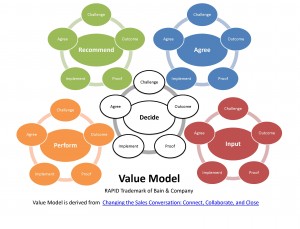Anyone that has ever worked with me for more than an hour or so has seen me address customer behaviors and understanding what makes them tick. As I like to say, we must understand the people at the table. The tool that I typically use for this discussion is Bain’s RAPIDTM framework example. RAPID is an acronym to explain the roles people play in a given situation:
- Recommend (A decision or next action)
- Agree (Must Agree on Subject, part of decision)
- Perform (Will be accountable once decision is reached)
- Input (provides input not part of decision)
- Decide (Commits Org to Action)
I seldom categorize or use all the categories in a real situation, but it is fun drawing pictures of the people at the table and where they fit. It does give you a good framework on how to frame individuals views and understand their needs better.
In the Business901 podcast, yesterday, Linda Richardson discussed her new book, Changing the Sales Conversation: Connect, Collaborate, and Close. She touched upon one area that intrigued me a great deal, the Value Model. In the value mode, she discusses the importance of understanding and planning to address the different people or departments that are part of the decision process. Instead of making up a fictitious company with names, I just used the RAPID template for the representative sample.
After reading the book and what I would recommend mapping out each department and individual based on these five factors.
- Challenge: Problem to be solved
- Outcome: Define the impact of the outcome
- Proof of Success: Metrics, Success Story, Financial
- Implementation: Review Roles, Time Frames
- Gain Client Agreement
Of course, the amount of granularity will depend a great deal on how much that individual role will affect the outcome. And, there may be the same problems or outcomes for 1 or more roles. What I took from the book is that these should be done somewhat in this order but without mapping this out, you can leave yourself at a significant disadvantage. As more and more decisions are being made by committee, our understanding must adjust. We can no longer just look to the decision maker.
 Equally important as we address value in use, Service Dominant Perspective (SD-Logic), the outcomes and implementations become much more important. The Performer’s role become very significant and as equally important as committing the organization to action (Decide). The sketch I put together lacks one overarching circle where we must address the overall Value Model for the organization.
Equally important as we address value in use, Service Dominant Perspective (SD-Logic), the outcomes and implementations become much more important. The Performer’s role become very significant and as equally important as committing the organization to action (Decide). The sketch I put together lacks one overarching circle where we must address the overall Value Model for the organization.
Related Podcast: The New Sales Conversation: Connect, Collaborate, Close
Lean Sales and Marketing: Learn about using CAP-Do

Comments are closed.